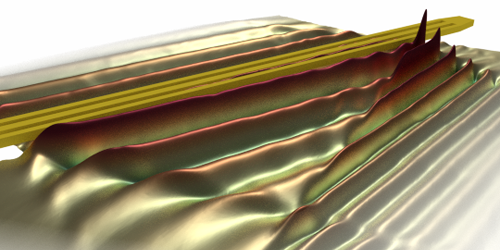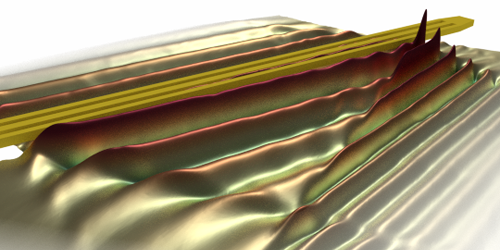How Spin Waves Bend
As light passes through a boundary between two materials, it changes speed, which causes the beam to reflect and refract. The angle between the incident and refracted waves depends on how large the speed change is and can be accurately predicted via the well-known Snell’s law. Experiments performed by Christian Back from the University of Regensburg, Germany, and colleagues show that a similar law can be derived for reflecting and refracting spin waves. This finding could help researchers design structures that direct the path of spin waves, and the information they carry, through circuits.
The group used a magnetic film patterned into two regions with different thicknesses. Since the dispersion of the waves depends on thickness, this created an interface at which the waves were refracted. An external magnetic field was applied to ensure a uniform magnetization across the sample. They launched a spin wave by exciting the material with a high-frequency current and then tracked the wave as it propagated through the material and crossed the interface. The authors observed wave-refraction features: The spin wave’s wavelength and amplitude changed, and reflected and refracted spin waves formed. However, they also observed deviations from Snell’s law predictions for light.
For spin waves, the researchers showed that the magnetization of the material, the externally applied magnetic field, and dipolar interactions also have to be accounted for. Their derivations revealed that the angle between the spin waves and the applied magnetic field alters the wave dispersion, giving it a direction dependence not seen for light. Introducing their new dispersion relation in Snell’s law for light, Back and his co-workers formulated a Snell’s law for spin waves that correctly predicted their experimental results.
This research is published in Physical Review Letters.
–Katherine Wright
Katherine Wright is a Contributing Editor for Physics.





